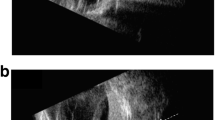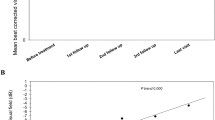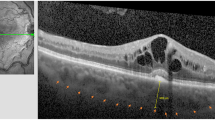Abstract
Purpose
The Sturge–Weber Syndrome (SWS) is a phacomatosis which include facial nevus flammeus, glaucoma, diffuse choroidal hemangioma, and leptomeningeal hemangiomatosis. External beam radiotherapy (EBRT) using photons was used to treat retinal detachment. We investigate the anatomical and functional results in a long-term basis.
Methods
Retrospective review of SWS patients treated by EBRT (20 Gy in 10 fractions) for an exudative diffuse choroidal hemangioma. Visual acuity, B-scan tumor thickness, size of retinal detachment, intra-ocular pressure, and hypotonic treatment were collected before EBRT, 1 year after, and at the latest news.
Results
Twenty-five patients (26 eyes) were treated between 2001 and 2014. Retinal detachment including the macula was found among twenty-six eyes before treatment. The average follow-up time was 47 months. The mean tumor thickness was initially 4.5 mm, 2.8 mm at first year, and 2.7 mm at the last visit. The retina was reattached at the last visit for all eyes except two. The visual acuity was stable or better for 20 eyes (p = 0.02). Four patients developed mild cataract during the follow-up.
Conclusion
EBRT using 20 Gy in 10 fractions is efficient, decreases tumor thickness, reattaches the retina, and stabilizes visual acuity. In the long term, retinal reattachment allows ocular conservation by preventing phthisis bulbi.
Similar content being viewed by others
Log in or create a free account to read this content
Gain free access to this article, as well as selected content from this journal and more on nature.com
or
References
Tallman B, Tan OT, Morelli JG, et al. Location of port-wine stains and the likelihood of ophthalmic and/or central nervous system complications. Pediatrics. 1991;87:323–7.
Sujansky E, Conradi S. Outcome of Sturge–Weber syndrome in 52 adults. Am J Med Genet. 1995;57:35–45.
Sujansky E, Conradi S. Sturge–Weber syndrome: age of onset of seizures and glaucoma and the prognosis for affected children. J Child Neurol. 1995;10:49–58.
Maiuri F, Gangemi M, Iaconetta G, et al. Sturge–Weber disease without facial nevus. J Neurosurg Sci. 1989;33:215–8.
Plate KH. Mechanisms of angiogenesis in the brain. J Neuropathol Exp Neurol. 1999;58:313–20.
Happle R. Lethal genes surviving by mosaicism: a possible explanation for sporadic birth defects involving the skin. J Am Acad Dermatol. 1987;16:899–906.
Anand R, Augsburger JJ, Shields JA. Circumscribed choroidal hemangiomas. Arch Ophthalmol. 1989;107:1338–42.
Madreperla SA, Hungerford JL, Plowman PN, et al. Choroidal hemangiomas: visual and anatomic results of treatment by photocoagulation or radiation therapy. Ophthalmology. 1997;104:1773–8.
Schilling H, Sauerwein W, Lommatzsch A, et al. Long-term results after low dose ocular irradiation for choroidal haemangiomas. Br J Ophthalmol. 1997;81:267–73.
Rumen F, Labetoulle M, Lautier-Frau M, et al. Sturge–Weber syndrome: medical management of choroidal hemangiomas. J Fr Ophtalmol. 2002;25:399–403.
Scott TA, Augsburger JJ, Brady LW. et al. Low dose ocular irradiation for diffuse choroidal hemangiomas associated with bullous nonrhegmatogenous retinal detachment. Retina. 1991;11:389–93.
Levy-Gabriel C, Rouic LL, Plancher C, et al. Long-term results of low-dose proton beam therapy for circumscribed choroidal hemangioma. Retina. 2009;29:170–75.
Chan RV, Yonekawa Y, Lane AM. et al. Proton beam irradiation using a light-field technique for the treatment of choroidal hemangiomas. Ophthamologica. 2010;224:209–16.
Zeisberg A, Seibel I, Cordini D, et al. Long-term (4 years) results of choroidal hemangioma treated with proton beam irradiation. Graefes Arch Clin Exp Ophthalmol. 2014;252:1165–70.
Plowman PN, Harnett AN. Radiotherapy in benign orbital disease. I: Complicated ocular angiomas. Br J Ophthalmol. 1988;72:286–8.
Ron E. Ionizing radiation and cancer risk: evidence from epidemiology. Pediatr Radiol. 2002;32:232–7.
Léauté-Labrèze C, Dumas de la Roque E, Hubiche T. Propranolol for severe hemangiomas of infancy. N Engl J Med. 2008;358:2649–51.
Krema H, Yousef YA, Durairaj P, et al. Failure of systemic propranolol therapy for choroidal hemangioma of Sturge–Weber syndrome: a report of 2 cases. JAMA Ophthalmol. 2013;131:681–3.
Tsipursky MS, Golchet PR, Jampol LM. Photodynamic therapy of choroidal hemangioma in Sturge–Weber syndrome, with a review of treatments for diffuse and circumscribed choroidal hemangiomas. Surv Ophthalmol. 2011;56:68–85.
Sullivan TJ, Clarke MP, Morin JD. The ocular manifestations of the Sturge–Weber syndrome. J Pediatr Ophthalmol Strabismus. 1992;29:349–56.
Thomas-Sohl KA, Vaslow DF, Maria BL. Sturge–Weber syndrome: a review. Pediatr Neurol. 2004;30:303–10.
Selbach JM, Posielek K, Steuhl KP, et al. Episcleral venous pressure in untreated primary open-angle and normal-tension glaucoma. Ophthalmologica. 2005;219:357–61.
Phelps CD, Armaly MF. Measurement of episcleral venous pressure. Am J Ophthalmol. 1978;85:35–42.
Olsen KE, Huang AS, Wright MM. The efficacy of goniotomy/trabeculotomy in early-onset glaucoma associated with the Sturge–Weber syndrome. J AAPOS. 1998;2:365–8.
Tannous Z, Rubeiz N, Kibbi AG. Vascular anomalies: portwine stains and hemangiomas. J Cutan Pathol. 2010;37:88–95.
Ong T, Chia A, Nischal KK. Latanoprost in port wine stain related paediatric glaucoma. Br J Ophthalmol. 2003;87:1091–3.
Yang CB, Freedman SF, Myers JS, et al. Use of latanoprost in the treatment of glaucoma associated with Sturge–Weber syndrome. Am J Ophthalmol. 1998;126:600–2.
Author information
Authors and Affiliations
Corresponding author
Ethics declarations
Conflict of interest
The authors declare that they have no competing interests.
Rights and permissions
About this article
Cite this article
Randon, M., Lévy-Gabriel, C., Abbas, R. et al. Results of external beam radiotherapy for diffuse choroidal hemangiomas in Sturge–Weber syndrome. Eye 32, 1067–1073 (2018). https://doi.org/10.1038/s41433-018-0024-4
Received:
Revised:
Accepted:
Published:
Issue date:
DOI: https://doi.org/10.1038/s41433-018-0024-4



